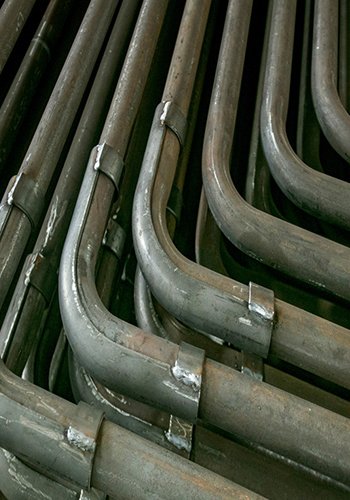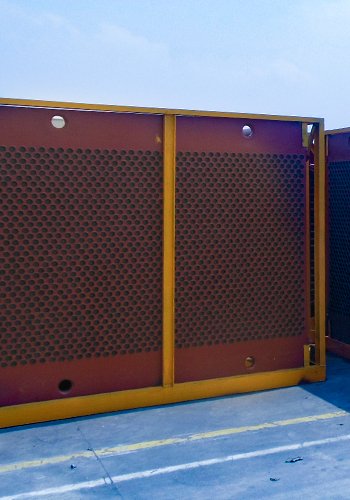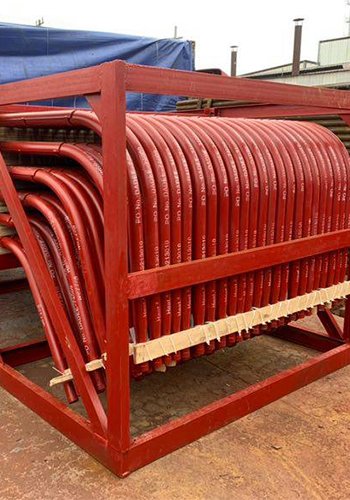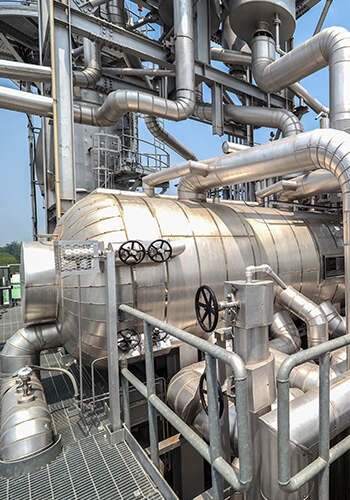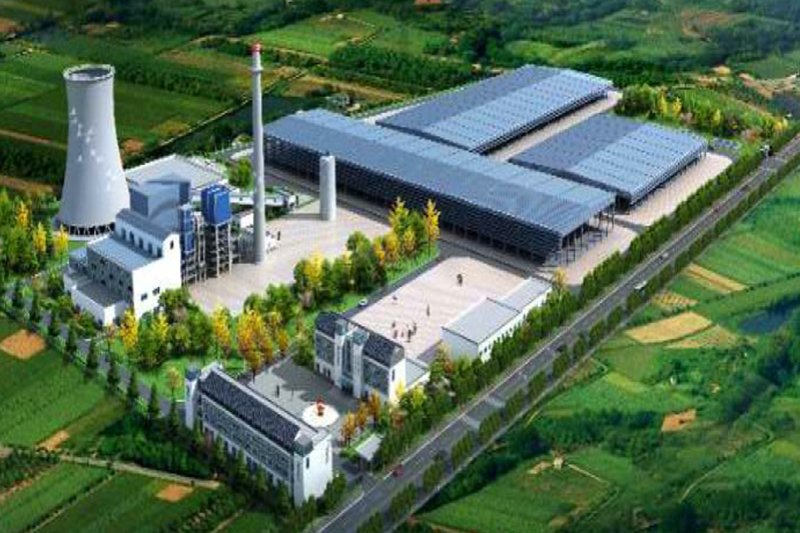With the improvement of living standards, the annual generation of household waste continues to increase. Prolonged waste disposal poses a destructive impact on environmental resources. Initially, methods such as burial and stacking were employed for household waste disposal. However, as sanitation facilities have been upgraded, methods like sanitary landfill, high-temperature composting, and incineration have gradually taken precedence. Incineration has emerged as a primary method for waste treatment in cold regions, facilitating harmless, reduced, and resource-oriented waste disposal.
Cold regions are characterized by prolonged winters and low temperatures. Taking a city in Heilongjiang Province as an example, the average annual temperature is 3.2°C, with January averaging -25.7°C and July averaging 22.8°C. The highest recorded temperature was 33.68°C on June 26, 1980, while the lowest was -39.5°C on January 8, 1956. Due to the influence of winter temperatures, waste in cold regions tends to freeze and clump together, hindering its dispersion. The moisture in frozen waste is trapped, resulting in a high moisture content. For instance, in a city in Heilongjiang, the original waste has a moisture content of 58.67%, and at 15°C, the calorific value is 5107 kJ/kg. Extrapolating, the calorific value at -25.7°C is 4842 kJ/kg. The low calorific value not only affects the combustion state of waste in the incinerator but also increases the slag burning reduction rate.
To address the challenges of waste freezing and low calorific value in winter in cold regions, this article summarizes measures such as promoting waste fermentation and waste pretreatment. It also introduces a practical engineering example of waste incineration design in cold regions to better ensure effective waste combustion during the winter season.
Promotion of Household Waste Fermentation Measures
In cold regions during winter, where outdoor temperatures are low, household waste left outdoors for an extended period tends to freeze and clump together due to ice formation. Considering factors such as anti-corrosion measures inside waste pits and the impact of garbage handling, it is not advisable to install heating pipelines inside the waste pits. Therefore, when frozen household waste is transported to the incineration plant, relying solely on the 5°C heating design temperature on the waste unloading platform for heat exchange results in a prolonged thawing time and an inability to reach the required waste fermentation temperature of 15°C. As a result, certain measures need to be taken. To promote household waste fermentation, measures such as pre-heating before entering storage and increasing ambient temperatures after storage can be implemented.
1.1 Pre-heating of Frozen Waste Before Storage
When unloading frozen waste, measures can be taken to use heated wastewater or the heated leachate for thermal assistance.
1.1.1 Utilizing Heated Wastewater to Heat Waste
Heated wastewater primarily comes from the continuous discharge of wastewater from the waste heat boiler steam drum. Continuous discharge is necessary to maintain the rated salt content of the boiler water, usually releasing water from the part of the steam drum with the highest salt content. Under normal circumstances, the wastewater continuously discharged from the boiler steam drum enters the continuous discharge expansion tank and, in winter, is switched into the waste pit through valves. At the same time, flash steam can also serve as a heat source for heating the waste. Utilizing continuous discharge wastewater from the steam drum for heating waste directly exchanges heat with the working medium, resulting in higher thermal efficiency. Moreover, it avoids wasting higher-quality hot water or steam, making it an economically advantageous solution.
1.1.2 Utilizing Heated Leachate to Heat Waste
Household waste leachate contains various microorganisms that, under certain temperature conditions, can promote waste fermentation. Therefore, in extremely cold regions, it is advisable to consider installing a leachate circulation heating device. The leachate collected in the leachate collection pool on the side of the waste pit is heated by introducing it into the steam turbine second extraction for steam extraction. The heated leachate is sprayed onto the frozen waste through a nozzle at the unloading port, effectively heating the frozen waste promptly. This method is characterized by high heat exchange efficiency and simultaneously reduces the leachate treatment process, providing a certain effect on thawing frozen waste.
1.2 Increasing Environmental Temperature and Extending Garbage Storage Time after Storage
In cold regions, the winter heating design temperature of the garbage unloading platform is 5°C, while outdoor temperatures can reach below -15°C. To maintain negative pressure in the garbage pit, the primary air for the waste incineration plant is drawn from the garbage pit. Due to the low outdoor temperatures, this results in the intake of cold air at lower temperatures into both the garbage unloading platform and the garbage pit. This not only disrupts the heating balance of the garbage unloading platform but also reduces the ambient temperature above the garbage pit, impacting waste fermentation. To promote waste fermentation, it is necessary to raise the ambient temperature above the garbage pit and increase the garbage pit’s capacity.
1.2.1 Raising the Ambient Temperature Above the Garbage Pit
The waste stored in the garbage pit is one of the main sources of odor pollution in the incineration plant. To counteract odors, gas is extracted from the garbage pit as combustion air for the incinerator, allowing odor substances to decompose under high-temperature conditions while maintaining negative pressure inside the garbage pit. Taking a waste incineration plant in a city in Heilongjiang as an example, to ensure negative pressure in the garbage pit and stable combustion in the incinerator, the primary air volume requires 86,000 Nm³/h. Of this, 30,000 Nm³/h of air at a temperature of 140°C is removed from the wet decomposition processing workshop, while the remaining 56,000 Nm³/h of air is drawn from the external environment. In January, the average temperature in this city drops to as low as -25.7°C.
The usual path for primary air intake involves external ambient air passing through the garbage unloading platform, garbage unloading doors, the garbage pit, and then entering the incinerator. However, the heating design temperature for the unloading platform is 5°C, and the intake of cold air at a flow rate of 56,000 Nm³/h and a temperature of -25.7°C causes a decrease in the ambient temperature inside the garbage unloading platform and pit. This affects indoor heating, preventing the thawing and fermentation of frozen waste. Therefore, it is necessary to alter the path of primary air intake.
Taking the waste incineration plant in Heilongjiang Province as an example, the primary air steam-air preheater is divided into two groups—one placed on the unloading platform and the other in the incineration plant. The preheater on the unloading platform heats the primary air to 5°C in advance and then delivers the warm air to the unloading platform and subsequently into the garbage pit through a pipeline. Simultaneously, the primary air fan extracts gas heated to 5°C from the garbage pit into another group of steam-air preheaters located in the incineration plant. The gas is further heated to 220°C before being introduced into the incinerator as combustion support. This modified air intake path not only maintains the heating balance of the unloading platform but also increases the ambient temperature above the garbage pit, effectively promoting waste fermentation.
1.2.2 Increasing Garbage Pit Capacity
Household waste is a complex mixture of various discarded items, and its moisture content fluctuates seasonally. In regions with heavy rainfall or abundant fruits and vegetables, such as during July and August in the southern hemisphere, the moisture content of waste tends to be higher. In cold regions with long winter seasons and significant snowfall, the moisture content of waste during winter weather is also higher. During the process of collecting waste into the garbage pit for storage, there is a fermentation period of 5 to 7 days involving turning and storing.
At room temperature, waste undergoes fermentation, and through a series of compression and biochemical reactions, external and internal moisture is released, reducing the moisture content of the waste by approximately 15%. This, in turn, lowers the waste’s moisture content and increases its calorific value before entering the furnace. However, in cold regions during winter, due to the need for thawing and heat absorption, the effective volume of the garbage pit for the conventional 5 to 7 days of waste storage is relatively small. Therefore, increasing the garbage pit capacity is essential. According to engineering experience, reducing the number of garbage unloading doors used for waste storage effectively increases the storage volume of the garbage pit.
Garbage Pre-treatment Measures
To enhance heat exchange and achieve the waste fermentation temperature, in addition to the aforementioned measures, it is advisable to consider incorporating pre-treatment measures into the design. These measures aim to crush frozen waste, reduce particle size, facilitate rapid thawing and melting of frozen waste within a short period, decrease the moisture content in the waste, thereby increasing the waste calorific value, and ensuring the stable operation of the incinerator. Garbage pre-treatment measures include the installation of a garbage crushing pre-treatment system and a garbage wet digestion pre-treatment system.
2.1 Installation of Garbage Crushing Pre-treatment System
The garbage crushing pre-treatment system comprises a garbage lifting feeding system, garbage conveying system, hydraulic crushing system, and deodorizing system. After being transported via a conveyor belt or chain plate to the hydraulic crusher, frozen waste is crushed, and the particle size is homogenized. Initially, to ensure fluidization, a fluidized bed waste incinerator requires the addition of a pre-treatment system, whereas a grate furnace, being a layered combustion system, does not necessitate a pre-treatment system. However, in cold regions, to expedite the thawing of frozen waste, the introduction of this crushing pre-treatment system into the grate furnace is considered.
After being crushed by the crusher, the particle size of the frozen waste generally remains between 200 and 250 mm. Through diligent turning during the waste stacking process in the garbage pit, along with increased gravity compression, the moisture in the waste is encouraged to be expelled as much as possible, maintaining stable combustion in the grate furnace during the winter season.
In a waste incineration plant in a city in Heilongjiang, two 600 t/d grate furnace incineration lines were established. Before the installation of the crushing pre-treatment system, auxiliary fuel needed to be added in winter to meet the requirement of a residence time in the secondary combustion chamber of the furnace not less than 2 seconds at a temperature not lower than 850°C. Failure to meet this requirement would result in the emission of pollutants from the incinerated waste not meeting the emission standards. After the installation of two hydraulic crushers, the particle size of the waste was reduced to 200-250 mm. After homogenization, the speed of garbage compression and melting accelerated. After storing for some time, the leachate yield reached 8% of the total waste volume (before homogenization, the leachate yield was nearly zero). The calorific value of the waste increased, ensuring stable combustion without the need for additional auxiliary fuel.
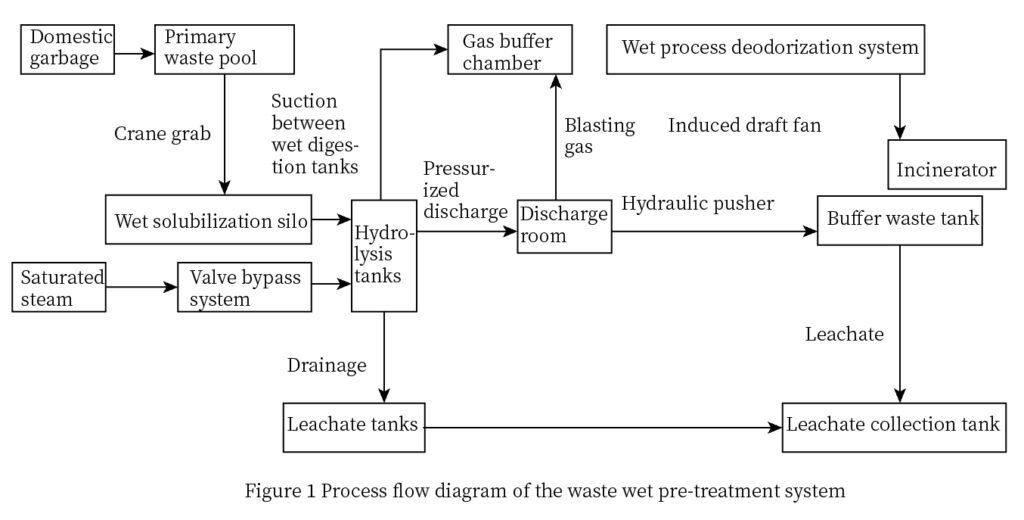
2.2 Installation of Garbage Wet Digestion Pre-treatment System
The garbage wet digestion pre-treatment system is a direct heating pre-treatment system for garbage. It includes a garbage lifting feeding system, wet digestion tank wet digestion pre-treatment system, hydraulic pushing machine system, deodorizing system, and more. The process flow of the wet digestion pre-treatment system is illustrated in Figure 1. The mechanism of the wet digestion pre-treatment system involves the use of steam under certain pressure to degrade the garbage in a sealed wet digestion tank under stable pressure. It consists of the wet digestion tank, fast-opening feed door, discharge valve, steam inlet valve, steam outlet valve, level gauge, and pressure gauge, with the wet digestion tank being the core system.
Untreated household waste is grabbed by the garbage lifting feeding system and deposited into the hopper of the wet digestion tank. The hopper is equipped with an automatic metering device and a level gauge. Once a certain quantity is reached, the wet digestion tank is sealed, and saturated steam at 0.8 MPa is introduced into the tank. Under the combined action of steam and catalyst, high-temperature wet digestion is conducted for 90 to 120 minutes. During this process, easily biodegradable organic waste (kitchen waste, paper, grass, leaves) undergoes degradation, sterilization, dehydration, and reduction, transforming into stable humus in the form of powder, fibers, and granules. In contrast, non-biodegradable organic and inorganic materials remain unchanged, and the bound water in the waste is converted into free water. After high-temperature wet digestion, pressurized discharge is carried out, and the depressurization process has a conveying, flash vaporization drying, expansion, mixing, crushing, and separation effect on the materials. The discharged materials are conveyed to the buffer garbage pit through the hydraulic pushing machine system at the bottom of the wet digestion tank.
After processing through this system, the garbage is disaggregated, particle size is homogenized, moisture content is reduced, and the calorific value of the waste is significantly increased. According to experimental studies, after wet digestion, the moisture content of household waste decreased from 53.81% to below 35%, and the calorific value of the waste increased by approximately 3000 kJ/kg. During the discharge process, the instantaneous pressurized discharge results in a shock wave that instantly breaks down the individual structure of the waste, homogenizing the particle size. Homogenized waste burns more easily.
Considering that household waste in cold regions during winter is prone to freezing, with almost no leachate yield, leading to a lower calorific value of the waste and affecting stable furnace combustion, the introduction of garbage wet digestion pre-treatment technology in waste incineration plants in cold regions becomes crucial. By combining the wet digestion pre-treatment process with the waste incineration process, high calorific value waste after wet digestion is mixed with untreated waste for co-fermentation. After co-fermentation, the calorific value of the waste entering the furnace can reach the designed calorific value, and the incinerator can operate stably without the need for additional auxiliary fuels. The garbage wet digestion pre-treatment system, when integrated with the incineration plant, not only effectively utilizes the plant’s steam resources but also enhances the calorific value of the waste entering the incinerator, reducing pollutant emissions. Additionally, it utilizes the incineration plant’s waste feeding system, garbage pit storage system, leachate collection system, and garbage pit deodorizing system.
Engineering Case Study
Taking a waste incineration plant in a city in Heilongjiang Province as an example, the design scale includes two 400 t/d grate furnaces, and additional systems such as the steam heating system for the unloading platform and the garbage wet digestion pre-treatment system were implemented. The garbage wet digestion pre-treatment system shares the feeding system with the incineration plant and requires saturated steam at 0.8 MPa, which is the depressurized extraction steam from the incineration plant’s turbine, for the wet digestion system. The odorous gas produced by the depressurization of the wet digestion system is treated and released into the garbage pit. Simultaneously, flash steam from the garbage pit is drawn into the incinerator by the primary air fan for combustion.
To ensure stable operation of the incinerator during winter, the steam heating system for the unloading platform and the garbage wet digestion pre-treatment system are activated. When the equipment is in operation, the primary air, after passing through the steam heating system for the unloading platform, maintains a temperature above 5°C on the unloading platform, ensuring a balanced heating environment. Additionally, the temperature of the primary air passing through the garbage pit is also above 5°C, improving the environmental temperature above the garbage. The frozen garbage, after processing through the wet digestion pre-treatment system, is dissolved and dispersed, raising the garbage temperature to above 65°C, resulting in approximately 17% leachate yield, a significant increase compared to garbage not subjected to wet digestion pre-treatment.
The processing capacity of the garbage wet digestion pre-treatment system is 50% of the total waste treatment capacity. It undergoes mixed fermentation with untreated waste, achieving a calorific value matching the furnace’s design value, and the evaporation capacity can be fully loaded.
Conclusion
In cold regions, the low winter temperatures pose challenges to waste incineration, as the moisture in household waste easily freezes, resulting in a low calorific value below 500 kJ/kg. Without the use of auxiliary burners, ensuring that the flue gas lingers for 2 seconds at a temperature of 850°C in the secondary combustion chamber becomes difficult. Simultaneously, controlling the furnace slag’s heat burning reduction rate to within 5% is challenging. Measures need to be taken to eliminate moisture from frozen waste, thereby improving its calorific value. By implementing actions such as raising the environmental temperature above the waste pit and introducing a wet digestion pre-treatment system, not only can the balance of the waste unloading platform heating system be ensured, but also the rapid thawing of frozen waste, thus enhancing its calorific value. This ensures stable combustion even in extremely cold winter conditions.
Additionally, considering the complexity of frozen waste processing in cold regions and the high energy consumption involved, it is recommended to enhance anti-freezing measures in the waste collection and transportation system. This could include minimizing outdoor waste storage time, installing heating equipment in transfer stations, and expediting waste removal to prevent waste freezing.
